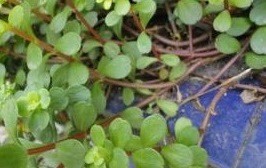Sedum emarginatum
(Sedum emarginatum)

Description
Sedum is a large genus of flowering plants in the family Crassulaceae, members of which are commonly known as stonecrops. The genus has been described as containing up to 600 species, subsequently reduced to 400–500. They are leaf succulents found primarily in the Northern Hemisphere, but extending into the southern hemisphere in Africa and South America. The plants vary from annual and creeping herbs to shrubs. The plants have water-storing leaves. The flowers usually have five petals, seldom four or six. There are typically twice as many stamens as petals. Various species formerly classified as Sedum are now in the segregate genera Hylotelephium and Rhodiola. Well-known European species of Sedum are Sedum acre, Sedum album, Sedum dasyphyllum, Sedum reflexum (also known as Sedum rupestre) and Sedum hispanicum. Sedum is a genus that includes annual, biennial, and perennial herbs. They are characterised by succulent leaves and stems.The extent of morphological diversity and homoplasy make it impossible to characterise Sedum phenotypicaly. Distributed in mainly in temperate to subtropical climates the Northern hemisphere, extending to the Southern hemisphere in Africa and South America,being most diverse in the Mediterranean,Central America, Himalayas, and East Asia.In this respect, the two subgenera differ. Subgenus Sedum having a centre of diversity in Mexico, and Gormania in Eurasia with a secondary centre in N America. Sedum species are used as food plants by the larvae of some Lepidoptera species including the grey chi moth. In particular, Sedum spathulifolium is the host plant of the endangered San Bruno elfin butterfly of San Mateo County, California.Sedum lanceolatum is the host plant of the more common Parnassius smintheus found in the Rocky Mountains. As well as Sedum spathulifolium, many other species of Sedum serve the environmental role of host plants for butterflies. For example, the butterfly Callophrys xami uses several species of Sedum, such as Sedum allantoides, for suitable host plants.
Taxonomic tree:







